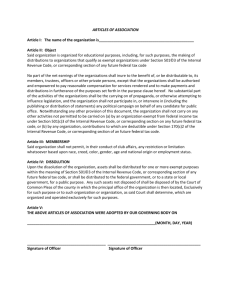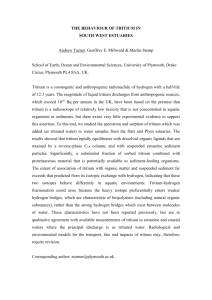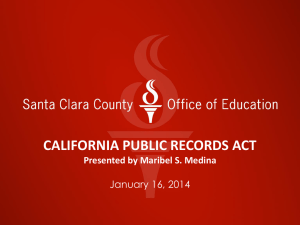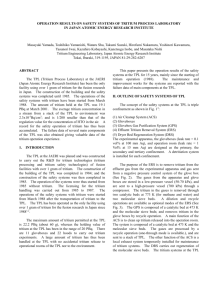DOC - ncrules.state.nc.us
advertisement
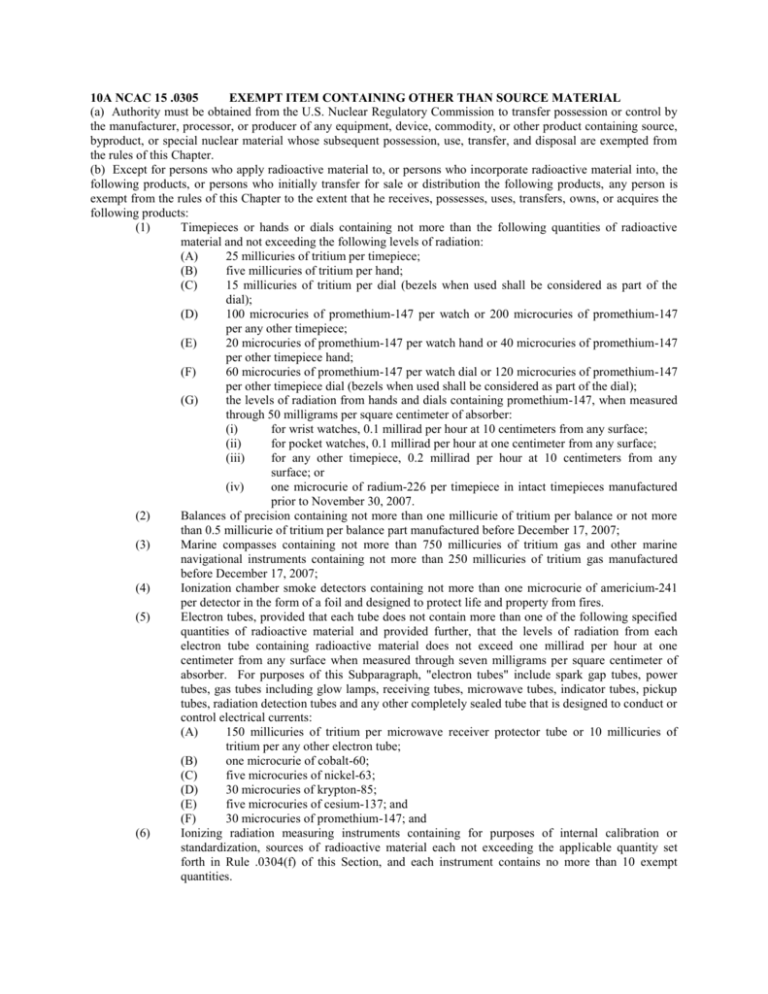
10A NCAC 15 .0305 EXEMPT ITEM CONTAINING OTHER THAN SOURCE MATERIAL (a) Authority must be obtained from the U.S. Nuclear Regulatory Commission to transfer possession or control by the manufacturer, processor, or producer of any equipment, device, commodity, or other product containing source, byproduct, or special nuclear material whose subsequent possession, use, transfer, and disposal are exempted from the rules of this Chapter. (b) Except for persons who apply radioactive material to, or persons who incorporate radioactive material into, the following products, or persons who initially transfer for sale or distribution the following products, any person is exempt from the rules of this Chapter to the extent that he receives, possesses, uses, transfers, owns, or acquires the following products: (1) Timepieces or hands or dials containing not more than the following quantities of radioactive material and not exceeding the following levels of radiation: (A) 25 millicuries of tritium per timepiece; (B) five millicuries of tritium per hand; (C) 15 millicuries of tritium per dial (bezels when used shall be considered as part of the dial); (D) 100 microcuries of promethium-147 per watch or 200 microcuries of promethium-147 per any other timepiece; (E) 20 microcuries of promethium-147 per watch hand or 40 microcuries of promethium-147 per other timepiece hand; (F) 60 microcuries of promethium-147 per watch dial or 120 microcuries of promethium-147 per other timepiece dial (bezels when used shall be considered as part of the dial); (G) the levels of radiation from hands and dials containing promethium-147, when measured through 50 milligrams per square centimeter of absorber: (i) for wrist watches, 0.1 millirad per hour at 10 centimeters from any surface; (ii) for pocket watches, 0.1 millirad per hour at one centimeter from any surface; (iii) for any other timepiece, 0.2 millirad per hour at 10 centimeters from any surface; or (iv) one microcurie of radium-226 per timepiece in intact timepieces manufactured prior to November 30, 2007. (2) Balances of precision containing not more than one millicurie of tritium per balance or not more than 0.5 millicurie of tritium per balance part manufactured before December 17, 2007; (3) Marine compasses containing not more than 750 millicuries of tritium gas and other marine navigational instruments containing not more than 250 millicuries of tritium gas manufactured before December 17, 2007; (4) Ionization chamber smoke detectors containing not more than one microcurie of americium-241 per detector in the form of a foil and designed to protect life and property from fires. (5) Electron tubes, provided that each tube does not contain more than one of the following specified quantities of radioactive material and provided further, that the levels of radiation from each electron tube containing radioactive material does not exceed one millirad per hour at one centimeter from any surface when measured through seven milligrams per square centimeter of absorber. For purposes of this Subparagraph, "electron tubes" include spark gap tubes, power tubes, gas tubes including glow lamps, receiving tubes, microwave tubes, indicator tubes, pickup tubes, radiation detection tubes and any other completely sealed tube that is designed to conduct or control electrical currents: (A) 150 millicuries of tritium per microwave receiver protector tube or 10 millicuries of tritium per any other electron tube; (B) one microcurie of cobalt-60; (C) five microcuries of nickel-63; (D) 30 microcuries of krypton-85; (E) five microcuries of cesium-137; and (F) 30 microcuries of promethium-147; and (6) Ionizing radiation measuring instruments containing for purposes of internal calibration or standardization, sources of radioactive material each not exceeding the applicable quantity set forth in Rule .0304(f) of this Section, and each instrument contains no more than 10 exempt quantities. (c) For purposes of Subparagraph (b)(5) of this Rule, where there is involved a combination of radionuclides, the limit for the combination shall be derived as follows: (1) Determine for each radionuclide in an ionizing radiation measuring instrument the ratio between the quantity present in the instrument and the exempt quantity established in Rule .0304 (f) of this Section for the specific radionuclide when not in combination; (2) No ratio shall exceed one and the sum of such ratios shall not exceed 10; and (3) For the purpose of Part (b)(8), 0.05 microcurie of americium-241 is considered an exempt quantity under Rule .0304 of this Section. (d) Self-luminous products are exempt as provided in this Paragraph. (1) Except for persons who manufacture, process, or produce self-luminous products containing tritium, krypton-85, or promethium-147, any person is exempt from the rules of this Chapter to the extent that the person receives, possesses, uses, transfers, owns, or acquires tritium, krypton-85 or promethium-147 in self-luminous products manufactured, processed, produced, imported, or transferred in accordance with a specific license issued by the U.S. Nuclear Regulatory Commission pursuant to Section 32.22 of 10 CFR Part 32, which license authorizes the transfer of the product to persons who are exempt from regulatory requirements. (2) The exemption in Subparagraph (d)(1) of this Rule does not apply to tritium, krypton-85, or promethium-147 used in products for frivolous purposes or in toys or adornments. (e) Gas and aerosol detectors are exempt as provided in this Paragraph. (1) Except for persons who manufacture, process, produce, or initially transfer for sale or distribution gas and aerosol detectors containing radioactive material, any person is exempt from the rules of this Chapter to the extent that the person receives, possesses, uses, transfers, owns or acquires radioactive material in gas and aerosol detectors designed to protect life or property from fires and airborne hazards provided that detectors containing radioactive material shall be manufactured, processed, produced, or initially transferred in accordance with a specific license issued by the U.S. Nuclear Regulatory Commission pursuant to Section 32.26 of 10 CFR 32, which authorizes the transfer of the detectors to persons who are exempt from regulatory requirements. (2) Gas and aerosol detectors previously manufactured and distributed to general licensees before November 30, 2007 in accordance with a specific license issued by an agreement state are exempt from the rules in this Chapter, provided that the devices are labeled in accordance with the specific license authorizing distribution of the general licensed device, and providing further that the devices meet the requirements of Rule .0327 of this Section. (f) Except as follows, any person is exempt from the requirements for a license set forth in this Section provided that such person receives, possesses, uses, transfers, owns or acquires capsules containing approximately one microcurie (37kBq) Carbon-14 urea each for "in-vivo" diagnostic use for humans: (1) Any person who desires to use the capsules for research involving human subjects shall apply for and receive a specific license from the agency; and (2) Any person who desires to manufacture, prepare, process, produce, package, repackage, or transfer for commercial distribution such capsules shall apply for and receive a specific license from the U.S. Nuclear Regulatory Commission. (g) Nothing in this Rule relieves persons from complying with applicable FDA and other federal regulations, and North Carolina requirements governing the receipt, administration, and use of drugs. History Note: Authority G.S. 104E-7; 104E-10(b); 104E-20; 10 CFR 30.15; 10 CFR 30.19; 10 CFR 30.20; Eff. February 1, 1980; Amended Eff. October 1, 2013; April 1, 1999; June 1, 1993; October 1, 1982; September 1, 1981; Transferred and Recodified from 15A NCAC 11 .0305 Eff. February 1, 2015.
